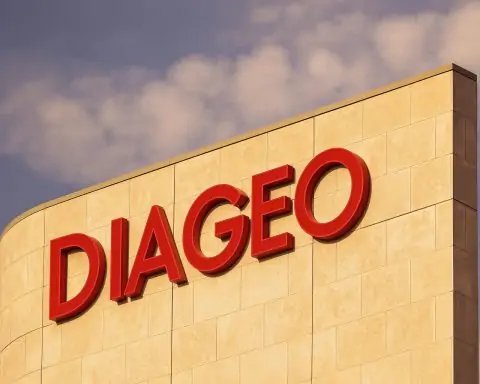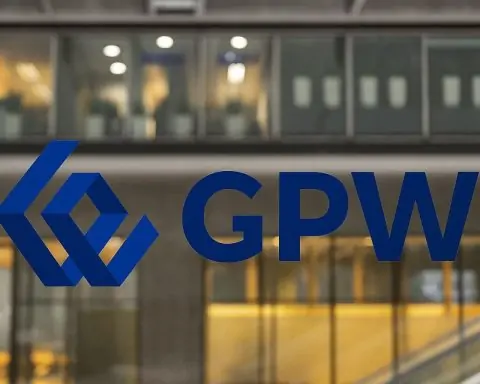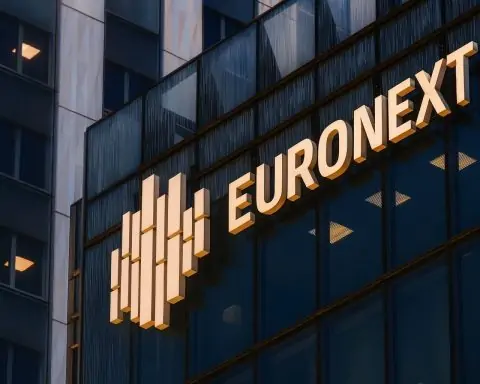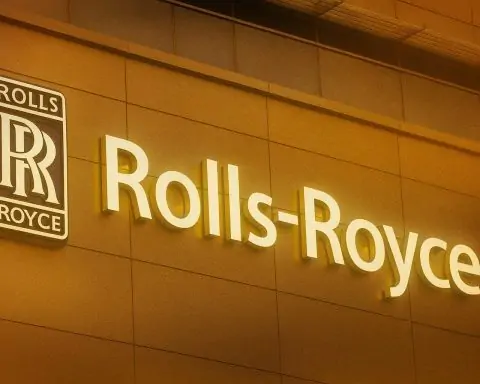- US Rescue Plan: On Oct. 9, the Trump Treasury announced a $20 billion support package for Argentina – including a new 20bn currency swap line and outright purchases of Argentine pesos – to shore up the country’s plunging currency [1]. Treasury Secretary Scott Bessent vowed to take “whatever exceptional measures” are needed to stabilize markets, though he insisted this was not a traditional bailout since no cash grants went to Buenos Aires [2] [3].
- Market Reaction: Argentine financial assets spiked on the news. 2035-dollar sovereign bonds jumped about 4.5 cents on the dollar, and the peso recovered roughly 0.8% (trading near 1,418 per USD) after earlier steep losses [4] [5]. Local stocks roared higher as well – the Buenos Aires Merval index surged over 5% on Oct. 9 [6] – while Argentine ADRs in New York rallied ~13%. Globally, US benchmarks stayed near record highs, though analysts caution a pullback could still come [7].
- Political Context: The aid is widely seen as a boost to Argentina’s libertarian President Javier Milei (an ally of Trump) ahead of legislative elections on Oct. 26 [8] [9]. Milei hailed the move as helping “make a hemisphere of economic freedom and prosperity” with his US partners [10]. But it’s proven controversial in Washington: Democratic lawmakers quickly introduced a “No Argentina Bailout Act” to bar use of US funds for foreign rescue [11] [12]. Even some Trump backers are uneasy – for example, US soybean farmers and their Congress members complain the deal helps Argentine soy exporters (who recently boosted sales to China) at the expense of American farmers [13] [14]. Senator Elizabeth Warren blasted the plan as “inexplicable” foreign support while parts of the US government remain unfunded [15].
- Strategic Rationale: Bessent emphasized that the move serves US interests: Argentina’s Milei has promised to eject Chinese influence and open up Argentina’s rich minerals to US investors. In fact, Bessent noted Milei’s pledge to “get China out of Argentina” and to allow US firms to develop rare earth and uranium resources [16]. He repeatedly stressed the US won’t lose money on the swap – the Treasury’s Exchange Stabilization Fund (ESF) has “never lost money” and he expects it to earn on this deal [17] [18]. In short, officials portray the package as a “lifeline” for a reformist ally that yields strategic trade and investment opportunities for the US.
- Economic Outlook: The US support comes as Argentina struggles with sky-high inflation, debt, and slim foreign reserves. Milei’s government has already slashed deficits and cut inflation from nearly 300% down to below 40% in the past year [19]. Analysts now forecast that inflation – which averaged about 220% in 2024 – will fall sharply in coming years (to around 20% by 2026) as growth rebounds [20] [21]. For example, Allianz Trade projects real GDP growth of roughly 4–5% in 2025 and 2026, with inflation plunging from ~118% at end-2024 to the low 20s by end-2025 [22]. But experts warn risks remain high: the peso is seen as overvalued given persistent price pressure [23] [24], and political consensus on further reforms is fragile. Pantheon Macroeconomics’ Andrés Abadía cautions that U.S. aid “bought time for Milei” but is “not a panacea,” noting that if Milei’s party fares poorly, “the negative political and financial noise would rush back” and inflation risks could resurge [25].
Details of the US Support Package
President Trump’s Treasury used its seldom-invoked crisis tools to prop up Argentina. The centerpiece is a $20 billion currency swap line between the US and Argentina’s central banks [26] – effectively a short-term dollar loan facility. In parallel, Treasury officials have directly bought pesos in open markets (in undisclosed amounts) to blunt the currency’s slide. Bessent announced these steps on Oct. 9 after several days of intensive talks in Washington with Economy Minister Luis Caputo (with IMF officials present) [27] [28]. On Truth Social, Bessent hailed Argentina’s “strong economic fundamentals” and Milei’s tough austerity measures. He vowed the US is “prepared, immediately, to take whatever exceptional measures are warranted” to stabilize the peso and bond markets [29] [30].
Treasury left the swap’s details confidential, but Bessent was explicit that no direct cash grant is going to Argentina’s treasury. In media appearances he insisted it is not a bailout of Buenos Aires – “we haven’t sent any money to Argentina,” he said, and insisted the ESF would not lose money on this deal [31]. Nonetheless, such currency-market interventions are exceedingly rare: only four times since 1996 has the US bought another country’s currency in global markets [32]. The IMF also publicly backed the move. Managing Director Kristalina Georgieva praised the US actions and said the IMF was “fully aligned” with Argentina’s fiscal discipline and exchange-rate strategy [33].
Market Reaction: Rally and Caution
Argentine markets immediately cheered the news. Late on Oct. 9, dollar bonds spiked and the peso strengthened. For example, the Argentine 2035 bond price jumped about 4.6 cents on the dollar, and the peso finished the session near 1,425/USD (up roughly 0.8% on the day) [34]. Local equity investors similarly gained confidence: the Merval (Buenos Aires stock index) climbed about 5.3% on the announcement, regaining ground from recent 2025 lows [35]. U.S.-traded Argentine ETFs and ADRs saw even bigger moves, reflecting inflows from reassured emerging-market funds.
One market strategist, Juan Perez of Monex USA, explained the move plainly: the peso “jumped” logically after the $20 billion swap was confirmed. He noted it fits with the Trump administration’s pattern of aiding governments that align with U.S. trade and strategic interests [36]. In short-term trading, investors had been testing Argentine valuations aggressively; many analysts say that without the promised US backstop, the peso “would have collapsed” entirely [37]. Eduardo Ordoñez of BankInvest said markets had been “hungry for details” of Bessent’s pledge, and without it “we would be talking about a complete collapse of Argentina.”
Nonetheless, U.S. markets did not share the euphoria. On Oct. 9 all three major U.S. stock indexes closed lower amid unrelated global concerns (e.g. a U.S. government shutdown, geopolitics) [38] [39]. Commodities moved little – oil eased back slightly after a Gaza ceasefire report [40], and gold dipped from its brief record highs above $4,000. Global sentiment remains cautious: JPMorgan CEO Jamie Dimon recently warned of “heightened risk” for a significant correction in U.S. stocks over the next 6–24 months [41]. Meanwhile, a prominent fund manager noted that the broad bull run in US equities is “very strong” and could pull back only later, suggesting few major investors have sold out on risk despite recent worries [42].
Political Fallout and Criticism
The bailout narrative immediately split along partisan lines. Inside Argentina, Milei and his coalition say the US move validates their reform agenda. Milei thanked Trump and Bessent on social media, calling America Argentina’s “closest of allies” and lauding the shared commitment to economic freedom [43] [44]. His team hoped that the market relief would help the ruling libertarian La Libertad Avanza party in Argentina’s Oct. 26 midterms, where it needs more seats to push through spending cuts and pro-business measures [45]. UBS strategist Shamaila Khan noted the announcement “is likely to bolster prospects” for Milei’s party, while Gramercy’s Kathryn Exum stressed that the midterms themselves – and a realignment of policy after the vote – remain the biggest factors ahead [46].
In Washington, however, political backlash mounted. Many Congressional Democrats (and some Republicans) were outraged that the U.S. might be using taxpayer resources to prop up an ally’s economy while parts of the U.S. government were unfunded. Senator Elizabeth Warren called it “inexplicable” that Trump would prop up a foreign government “while he shuts down our own” [47]. A bipartisan group promptly introduced the “No Argentina Bailout Act” to bar use of the Treasury’s Exchange Stabilization Fund on this deal [48] [49]. Even some allies of the administration grumbled privately: US soybean growers were furious that Argentina’s suspension of export taxes (encouraging big sales of soy to China) directly competed with American exports [50] [51]. The American Soybean Association’s president warned that one-time payments won’t “fix” the industry, lamenting that China’s massive demand (61% of world soy) can’t simply be rerouted away from Argentina [52].
Economic Reforms and IMF Ties
Underlying the crisis is Argentina’s long history of high inflation, debt defaults and volatile policies. Milei’s administration inherited an economy in recession with 220% inflation (2024 average) and a large fiscal gap. Since taking office in Dec. 2023, Milei has undertaken “shock therapy” reforms: he slashed spending to achieve a small budget surplus (about 0.3% of GDP in 2024, a swing from a 5% deficit) and reduced money-printing financing [53] [54]. This fiscal clampdown, plus a market-friendly business agenda, helped cool inflation dramatically (from nearly 300% early 2024 to under 40% by late 2025) [55]. Although growth has been weak (GDP still contracted ~1.7% in 2024) [56], analysts say the policy shift and an oil/soy export boom have begun to stabilize output and wages.
The US-backed swap complements Argentina’s existing program with the IMF. In April 2025 the IMF approved a new 4‑year, $20 billion loan to Argentina (the 23rd such arrangement since 1958) to help fund reserves and reforms [57]. The U.S. deal effectively adds more cushion alongside that IMF support. Allianz Trade points out that Argentina has even achieved an unofficial fiscal surplus (~0.6% of GDP) and expects strong growth around 4–5% in 2025 and 2026 [58], making it one of the fastest-growing big economies in the region if forecasts hold. Inflation, after more than two decades of double- or triple-digit rates, is now projected to plunge: from about 118% at end‑2024 to roughly 18–23% by end-2025, reaching single digits by 2027 [59]. In other words, economists foresee a sharp disinflation (assuming no policy reversals) as the currency regime stabilizes.
However, many experts caution that Milei’s program is far from guaranteed. The peso is widely seen as overvalued given the still-high inflation backdrop [60] [61]. With negative central-bank reserves and a crawling peg, any shock could force a devaluation and inflation spike. Market strategist Marc Chandler noted that while Bessent claimed the peso’s exchange-rate band was “fit for purpose,” markets clearly expect a devaluation soon [62]. If further rate hikes or fiscal loosening occur, the currency could weaken again. Pantheon’s Abadía warned that without strong election results, Milei’s agenda could stall and market volatility would return [63].
Analyst Forecasts and Outlook
Putting it together, analysts offer cautiously upbeat forecasts tempered by political risk. The consensus is that, assuming reform momentum continues, Argentina’s economy should rebound. Allianz Trade explicitly projects GDP +4.4% in 2025 and +3.5% in 2026 [64], with inflation falling sharply (averaging about 16–20% in 2026 [65]). The IMF itself projects similar growth (~5–5.5% this year) and sees inflation coming down (from ~300% to “under 40%” by early 2025, per recent analysis [66]). Any weaker-than-expected inflation would boost consumer buying power and growth further.
On the flip side, dangers abound. Past IMF programs for Argentina often ended prematurely [67]; this one will require discipline under Milei’s very controversial plans. Midterm election results later in October will be a major test of Milei’s mandate [68] [69]. Political fallout (labor unrest, rural strikes or backlash over austerity) could derail policies and shock markets. In addition, global factors like US-China tensions and commodity swings will impact Argentina heavily given its reliance on exports and foreign capital.
For now, the U.S. lifeline has at least temporarily calmed markets and given Buenos Aires breathing room. Argentine bond spreads have narrowed, the peso has steadied, and foreign funds are likely reevaluating their bets. As one Latin America analyst put it, the U.S. injection “bought some time for Milei” [70]. But many investors and economists will be watching closely: if Milei “performs badly in October,” Abadía warned, the “negative political and financial noise” will return, undoing this brief respite [71].
Sources: Reuters [72] [73] [74] [75] [76], Washington Post [77] [78], Al Jazeera [79], Euronews/AP [80] [81], Allianz Trade [82], Atlantic Council [83] and TechSpace2 (ts2.tech) [84].
References
1. www.reuters.com, 2. www.reuters.com, 3. www.reuters.com, 4. www.reuters.com, 5. www.reuters.com, 6. www.reuters.com, 7. www.reuters.com, 8. www.reuters.com, 9. www.reuters.com, 10. www.reuters.com, 11. www.reuters.com, 12. www.reuters.com, 13. www.washingtonpost.com, 14. www.euronews.com, 15. www.reuters.com, 16. www.reuters.com, 17. www.reuters.com, 18. www.reuters.com, 19. www.atlanticcouncil.org, 20. www.allianz-trade.com, 21. www.atlanticcouncil.org, 22. www.allianz-trade.com, 23. www.atlanticcouncil.org, 24. www.washingtonpost.com, 25. www.aljazeera.com, 26. www.reuters.com, 27. www.reuters.com, 28. www.aljazeera.com, 29. www.washingtonpost.com, 30. www.aljazeera.com, 31. www.reuters.com, 32. www.washingtonpost.com, 33. www.reuters.com, 34. www.reuters.com, 35. www.reuters.com, 36. www.reuters.com, 37. www.reuters.com, 38. www.reuters.com, 39. www.reuters.com, 40. www.reuters.com, 41. www.reuters.com, 42. www.reuters.com, 43. www.reuters.com, 44. www.euronews.com, 45. www.reuters.com, 46. www.reuters.com, 47. www.reuters.com, 48. www.euronews.com, 49. www.reuters.com, 50. www.washingtonpost.com, 51. www.euronews.com, 52. www.washingtonpost.com, 53. www.atlanticcouncil.org, 54. www.allianz-trade.com, 55. www.atlanticcouncil.org, 56. www.allianz-trade.com, 57. www.allianz-trade.com, 58. www.allianz-trade.com, 59. www.allianz-trade.com, 60. www.piie.com, 61. www.atlanticcouncil.org, 62. www.washingtonpost.com, 63. www.aljazeera.com, 64. www.allianz-trade.com, 65. www.allianz-trade.com, 66. www.atlanticcouncil.org, 67. www.allianz-trade.com, 68. www.reuters.com, 69. www.euronews.com, 70. www.aljazeera.com, 71. www.aljazeera.com, 72. www.reuters.com, 73. www.reuters.com, 74. www.reuters.com, 75. www.reuters.com, 76. www.reuters.com, 77. www.washingtonpost.com, 78. www.washingtonpost.com, 79. www.aljazeera.com, 80. www.euronews.com, 81. www.euronews.com, 82. www.allianz-trade.com, 83. www.atlanticcouncil.org, 84. ts2.tech










